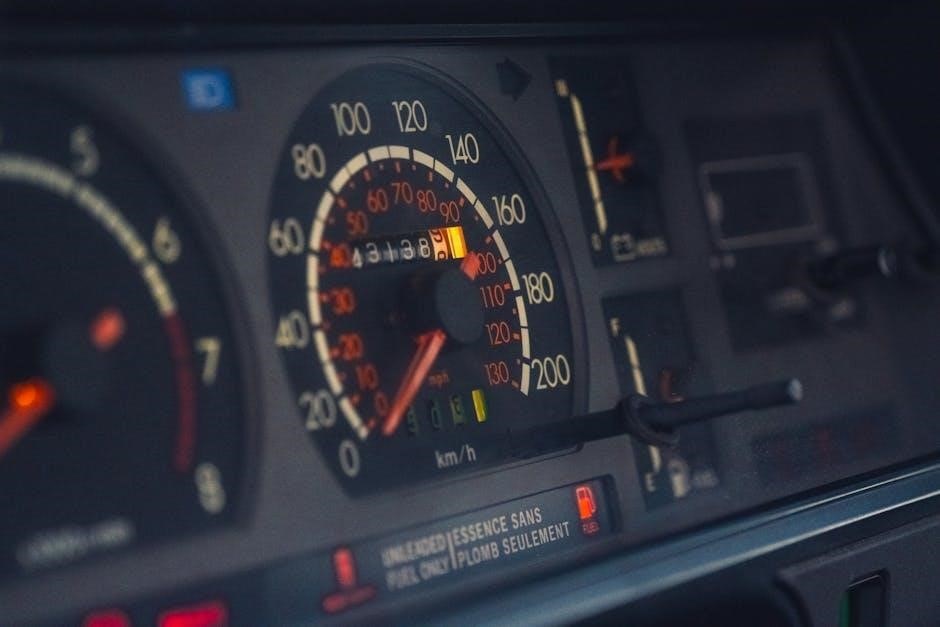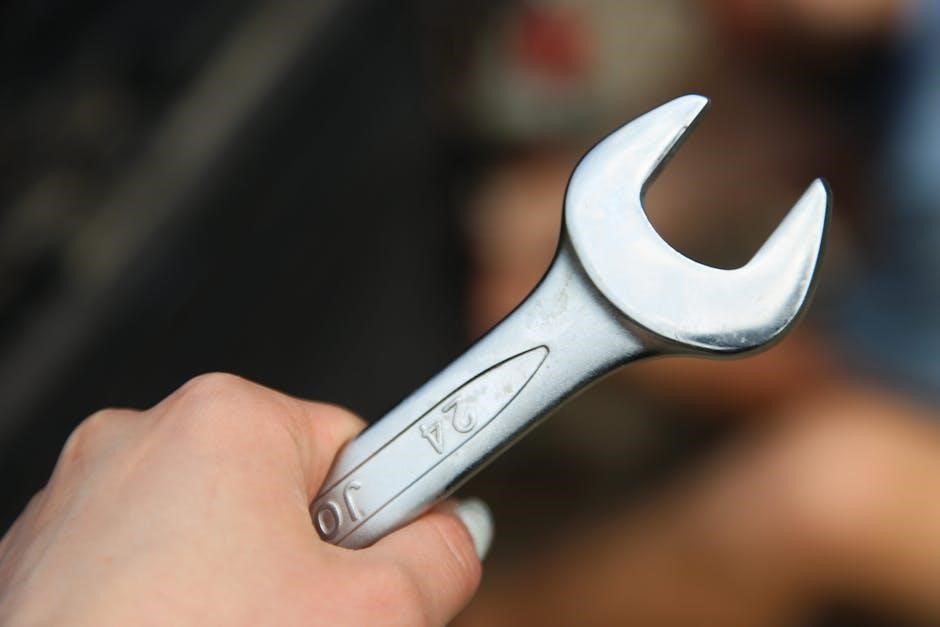Explore interactive fuse diagrams for Toyota RAV4. Understand fuse box locations and functions across different models. Essential for troubleshooting and maintaining electrical systems effectively.

Understanding the Fuse System
The fuse system protects electrical circuits from damage. Fuses act as circuit breakers, preventing overloads. Each fuse corresponds to specific components, ensuring safe and reliable vehicle operation.
2.1 Overview of the Fuse System in Toyota RAV4

The Toyota RAV4 fuse system is designed to protect electrical circuits from overloads. It consists of fuses and relays located in designated boxes. These boxes are typically found in the engine compartment and under the dashboard. The system ensures safe operation of electrical components like lights, infotainment, and safety features. Each fuse corresponds to specific functions, making diagnostics easier. The layout varies by model year, with detailed diagrams provided in the owner’s manual. Regular inspections are recommended to maintain functionality and prevent electrical issues. Understanding this system helps drivers identify and replace faulty fuses quickly, ensuring reliable vehicle performance.
2.2 Types of Fuses Used in Toyota RAV4
The Toyota RAV4 utilizes various fuse types to protect its electrical systems. Standard fuses, including mini and low-profile mini fuses, are commonly used for basic functions like lighting and accessories. High-current fuses are employed for power-hungry components such as the alternator and cooling fan. Additionally, relay modules are integrated into the fuse boxes to control high-power circuits efficiently. These components are designed to prevent electrical overloads and ensure safe operation. The specific fuse types and their ratings vary by model year, with detailed specifications outlined in the fuse diagrams. Proper identification and replacement of these fuses are crucial for maintaining the vehicle’s electrical integrity and performance.
2.3 Importance of the Fuse System
The fuse system in the Toyota RAV4 is crucial for protecting its electrical circuits from overloads and short circuits. Fuses act as sacrificial components, breaking the circuit to prevent damage to wiring, electronics, and connected devices. Without a functional fuse system, the vehicle could experience electrical fires, component failure, or irreversible damage to critical systems. The fuse system ensures safe and reliable operation of features like lighting, infotainment, and safety systems. Regular inspection and proper maintenance of fuses are essential to avoid disruptions and potential hazards. Understanding the fuse system is vital for diagnosing and resolving electrical issues efficiently, ensuring the vehicle remains operational and safe on the road.

Fuse Box Locations
Fuse boxes in Toyota RAV4 are located in the engine compartment and under the dashboard. Their locations vary by model year, with specific diagrams available for 2013-2018 and 2019-2022 models. Labels and diagrams help identify fuses for quick troubleshooting and repairs.
3.1 Fuse Box Locations in 2013-2018 Toyota RAV4 Models
In 2013-2018 Toyota RAV4 models, fuse boxes are strategically positioned for easy access. The primary fuse box, known as the “Junction Box,” is located in the engine compartment on the driver’s side. This box contains essential fuses for systems like the engine control unit and headlights. Additionally, a secondary fuse box is situated under the dashboard, near the glove compartment. This box houses fuses for interior components such as the air conditioning, radio, and power outlets. Both locations are clearly marked and can be identified using the diagrams provided in the owner’s manual or online resources. Regular inspection of these fuse boxes ensures proper electrical system functioning and helps in quick troubleshooting of any issues.
3.2 Fuse Box Locations in 2019-2022 Toyota RAV4 Models
In the 2019-2022 Toyota RAV4 models, the fuse boxes are located in two main areas for enhanced accessibility. The primary fuse box, housing critical fuses for major systems, is found in the engine compartment on the driver’s side; This box is labeled and contains fuses for components like the powertrain control module and advanced safety features. A secondary fuse box is located under the dashboard, near the driver’s knee area. This box manages fuses for interior functions such as the infotainment system, climate control, and USB ports. Both locations are designed for easy access and are detailed in the owner’s manual or online diagrams. Regular checks of these fuse boxes ensure optimal electrical performance and aid in swift identification of any issues that may arise.

Reading Fuse Diagrams
Understanding fuse diagrams is essential for identifying and troubleshooting electrical issues. Locate symbols, fuse labels, and their corresponding functions. Refer to the manual or online resources for precise interpretations and guidance.
4.1 Steps to Interpret Fuse Diagrams
Interpreting fuse diagrams for the Toyota RAV4 involves a few key steps. First, locate the fuse box diagrams specific to your vehicle’s model year, as they vary across generations. Next, identify the symbols and labels on the diagram, which correspond to different electrical components. Use the legend or key provided to understand the purpose of each fuse. Then, match the fuse numbers with their functions, such as “ECU-B NO.2” or “OBD.” Refer to the owner’s manual or online resources for precise interpretations. Finally, cross-check the diagram with the physical fuse box to ensure accuracy. This process helps in diagnosing issues and replacing fuses correctly.
4.2 Key Symbols and Components in Fuse Diagrams
Fuse diagrams for the Toyota RAV4 include essential symbols and components that guide users in understanding the electrical system. Key symbols include circles representing individual fuses, lines indicating connections, and labels identifying components like “ECU-B NO.2” for engine control units or “OBD” for onboard diagnostics. Relays are often depicted with rectangular symbols, while connectors are shown as small nodes. Color coding may highlight high-power or critical circuits. Each fuse is numbered and labeled according to its function, such as “Fusible MINI. 10A, 34” for specific systems. These symbols help users locate fuses quickly and understand their roles in powering systems like headlights or infotainment. Familiarizing yourself with these elements is crucial for diagnosing issues and ensuring proper repairs.

Common Fuses and Their Functions
In the Toyota RAV4, several fuses are commonly referenced due to their essential roles in the vehicle’s electrical system. The 10A fuse (often labeled as “H-LP LH-LO”) powers the left headlight’s low beam, ensuring proper illumination. The 7.5A fuse (“OBD”) is dedicated to the onboard diagnostics system, crucial for monitoring emissions and engine performance. Another key fuse is the 15A (“CIG”), which controls the cigarette lighter and power outlet, essential for charging devices. The 10A fuse (“H-LP RH-LO”) operates the right headlight’s low beam, mirroring its left counterpart. Lastly, the 20A fuse (“WIPER”) manages the windshield wiper motor, ensuring clear visibility during rain or snow. These fuses are vital for maintaining core vehicle functions and are frequently referenced in repair guides.

Troubleshooting Fuse-Related Issues
Identifying and resolving fuse-related problems in the Toyota RAV4 begins with understanding common symptoms. A blown fuse may cause issues like non-functional headlights, inoperative accessories, or electrical system malfunctions; Start by consulting the fuse diagram specific to your RAV4 model year to locate the relevant fuse. For example, the 10A fuse (“H-LP LH-LO”) controls the left headlight’s low beam, while the 7.5A fuse (“OBD”) manages the onboard diagnostics system. If a fuse is blown, replace it with one of the same amperage rating to avoid damaging the circuit. Always turn off the ignition and accessories before replacing a fuse. If issues persist, inspect the fuse box for corrosion or wear and consult a professional if necessary. Regular checks and proper maintenance can prevent electrical system failures, ensuring reliable performance and safety on the road.

Model-Specific Fuse Diagrams
Explore detailed fuse diagrams for Toyota RAV4 models, including 2006-2012, 2013-2018, and 2019-2022 iterations. These diagrams provide precise locations and functions for fuses, ensuring accurate repairs and maintenance;
7.1 Fuse Diagrams for 2006-2012 Toyota RAV4 Models
The 2006-2012 Toyota RAV4 models feature two primary fuse boxes: one under the hood and another beneath the dashboard. These diagrams detail fuse locations and functions, aiding in quick troubleshooting. Each fuse controls specific systems like lights or electronics. Consulting the owner’s manual or a repair guide provides a key to understanding fuse roles. Interactive diagrams online can offer additional clarity, making it easier to identify blown fuses and necessary replacements. Ensure diagrams match your vehicle’s model year for accuracy. Proper fuse replacement with the correct amperage rating is essential to prevent electrical damage. These resources help owners maintain and repair their vehicles effectively.
7.2 Fuse Diagrams for 2013-2018 Toyota RAV4 Models
The 2013-2018 Toyota RAV4 models have fuse diagrams that outline the locations and functions of fuses in both the engine compartment and interior fuse boxes. These diagrams are essential for identifying blown fuses and understanding which systems they control, such as lighting, electronics, and safety features. The fuse boxes are divided into types A and B, depending on the model’s configuration. Online resources provide interactive diagrams that allow users to explore fuse locations specific to their vehicle’s year and trim level. It’s crucial to refer to the correct diagram for accurate troubleshooting and maintenance. Always replace fuses with the specified amperage rating to avoid electrical issues. These diagrams are a valuable tool for both novice and experienced owners to ensure proper electrical system function.
7.3 Fuse Diagrams for 2019-2022 Toyota RAV4 Models

The 2019-2022 Toyota RAV4 models, part of the 5th generation (CA50W/XA50W), feature detailed fuse diagrams that outline the electrical system’s components. These diagrams are crucial for identifying fuse locations and their corresponding functions, such as the cigarette lighter fuse or the engine control unit; Fuse boxes are typically located under the instrumental panel and in the engine compartment, with clear labels for easy reference. Interactive diagrams available online provide a visual guide, making it easier to locate specific fuses. These resources are essential for troubleshooting electrical issues and ensuring proper maintenance. Always refer to the correct diagram for your vehicle’s model year to avoid confusion. Regular inspection of fuses is recommended to maintain optimal vehicle performance and safety.

Maintenance and Care Tips
Regular maintenance of your Toyota RAV4’s fuse system ensures optimal performance and prevents electrical issues. Always refer to your vehicle’s manual or online diagrams for accurate fuse identification. Inspect fuses periodically for signs of wear or damage. Replace blown fuses with ones of the correct amperage rating to avoid damage to circuits. Keep the fuse boxes clean and dry to prevent corrosion. When troubleshooting, use a fuse puller to remove fuses safely. Avoid overloading circuits, as this can cause fuses to blow frequently; Update your knowledge with the latest diagrams for your specific model year, especially for 2019-2022 models, which feature advanced electrical systems. By following these care tips, you can extend the lifespan of your vehicle’s electrical components and ensure reliability on the road.
